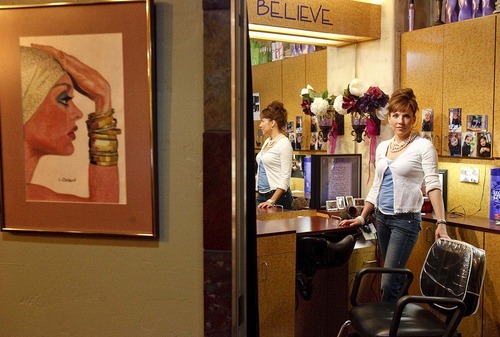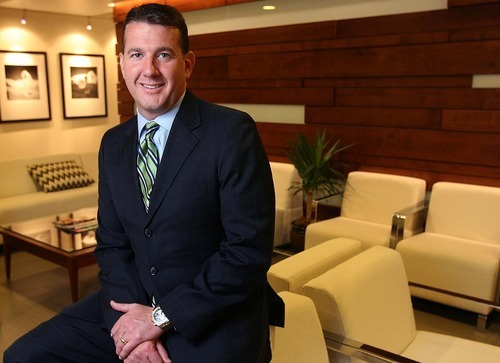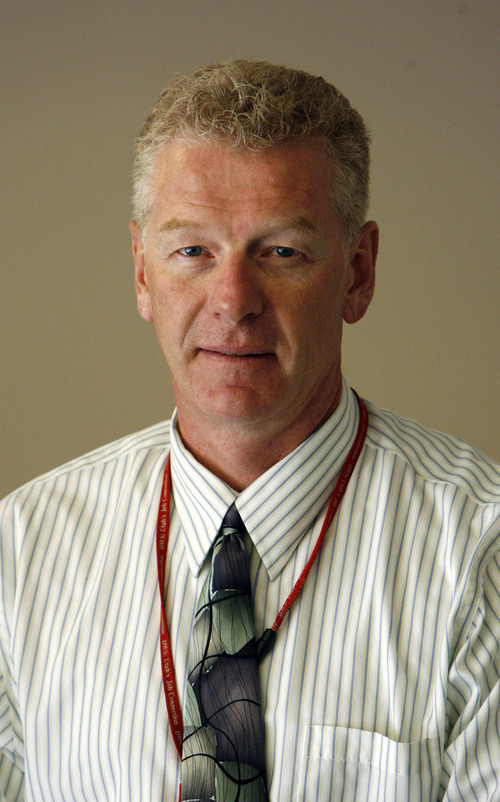This is an archived article that was published on sltrib.com in 2011, and information in the article may be outdated. It is provided only for personal research purposes and may not be reprinted.
With a tip of the hat to baseball sage Yogi Berra, the second anniversary of the Great Recession's official end this month feels like déjà vu all over again — and not in a good way.
After a promising start early this year, economic growth has slowed. The economy appears to be teetering, unable to decide whether to continue a frustratingly slow recovery or fall back into another downturn.
In January, "that's the way it felt," Mark Knold, chief economist for the Utah Department of Workforce Services, said of the U.S. and Utah economies. "Now there are question marks."
Although not all is doom and gloom, you don't have to be an economist to know something doesn't feel right:
• The gross domestic product in the first quarter was up a mere 1.8 percent, compared with a robust 3.1 percent in the last quarter of 2010. GDP is the total output of the U.S. economy and one of the best ways to measure its health.
• On the job front, after strong growth in the first four months of 2011, U.S. employers added just 54,000 positions in May, less than a third of what's needed to lower the unemployment rate, which ticked up to 9.1 percent.
• In Utah, 17,400 jobs were created in the year ending May 31. But the number was little changed from January, February, March or April. To Knold, that suggests most of the new jobs were generated 12 months earlier. "If you are not seeing much of an increase, it kind of tells you that not much is going on," Knold said. "It seems like the current employment market in Utah is slowing down a little bit."
• With the onset of May, stock values fell six of seven weeks, wiping out billions of dollars of hard-fought gains. At the start of last week, the Dow Jones industrial average was down 6.3 percent from its April 29 high. An official bear market correction is 10 percent.
• Two months ago, the view of many economists was that the economy would grow 3 percent to 3.8 percent over the next year. Now, based on later reports of lousy manufacturing data, disappointing auto sales and weak job growth, they have scaled back forecasts to 2 percent to 3 percent.
"Anxiety levels have risen, and because of that, hiring and consumer confidence levels have declined. All these anxieties simply make it easier for businesses to sit on its hands as far as expanding employment, with a similar performance from consumers in regard to spending," said Jeff Thredgold, an economist who consults for Zions Bank.
Thredgold is no parochial fortune teller. He speaks all over the country to business groups and leaders. For several years he was chief economist of KeyCorp, the Cleveland-based banking giant.
He sees symptoms of the country's turmoil everywhere and their unsettling effect on America's mood. Politicians fight over Obamacare and the nation's debt. The war in Afghanistan drags on. Worries about the European Union's failure to control the Greek debt crisis regularly send shock waves through financial markets.
Souring the mood along the Wasatch Front, home prices are down 15 percent since the recovery began — and still falling. Gasoline prices are up more than 40 percent in the past two years.
And just as confidence is down among consumers nationally, so it is with Terese Martinez of Magna, who works in customer service and whose dream of retirement is slipping away.
"I don't believe it," she said of the recovery. "It doesn't feel like it to me."
—
Pessimism is endemic • Thredgold feels consumers' anxiety. In his June newsletter marking the two-year anniversary of the start of the recovery, he itemizes 21 questions weighing on consumers and businesses that are tempering spending and growth.
"These anxieties are contributing to the fact that the economy is going to be growing at a less impressive rate for the next few quarters," Thredgold said.
Pessimism is endemic, with no magic bullet in sight to break the cycle of recessionary despair felt by many. AlixPartners, a business advisory firm, released an economic outlook survey for June that found 63 percent of Americans feel bad about the state of the U.S. economy. In May, only 49 percent felt so gloomy.
A nearly identical percentage of Americans don't expect to return to their pre-recession lifestyles until 2014, if ever. Ten percent said they don't expect to recover completely in their lifetimes.
In Utah, pessimism may not be as dark, but it is unmistakable. The Utah Consumer Attitude Index, a monthly report prepared for Zions Bank, fell from April to May. At 70.7, the index is well off a reading of 100, which indicates a healthy economy.
The Cicero Group, a Salt Lake City market research firm, constructed the Utah index. It's a blend of two sub-index numbers that gauge how people feel about current conditions and what they expect in the future, said CEO Randy Shumway.
The latest measure found the gap between present and future expectations narrowed in May, probably because Utahns are less certain about what lies ahead.
"The difference between those two numbers is not as great as it was five months ago, which demonstrates that some of the bad news that people are hearing is causing them to moderate their expectations for the ... future," Shumway said.
Some economists and analysts think Utahns are so anxious that they're unwilling to accept data that show the economy actually isn't heading for a double-dip recession.
Shumway is one. Despite its recent weakness, the stock market has rebounded significantly in the past two years, so Americans' 401(k) retirement portfolios are doing better, he said.
The ratio of consumer debt to income is down more than 10 percent. Personal savings have ballooned since marking all-time lows in the mid-2000s. And housing starts have fallen behind population growth. That eventually will generate a housing recovery, he said.
"The prognosis is so positive that what we are seeing is what I would characterize as the type of consumer gloom that is historically consistent after an economic crisis of the size we just experienced."
People, Shumway insisted, "are feeling better. But the pain was so deep that there are still real reservations."
Juliette Tennert, Gov. Gary Herbert's chief economist, is thankful she lives in Utah rather than next door in her home state of Nevada, where unemployment reached more than 14 percent and home values are still plunging.
"Our economy has definitely improved since the depths of the recession," Tennert said, then added: "Growth is maybe slower than we'd like, but we still are experiencing some good growth."
Tennert's evidence is laid out in the latest review of Utah economic indicators her office assembles several times a year. Released early this month, the review is the consensus of two dozen economists and other experts in and out of state government.
It is more upbeat than the previous version published in February. Although the summary downgraded estimates of vehicle sales and new home permits, it bumped up forecasts of 2011 job growth and taxable retail sales.
"The fact that the real estate market continues to struggle is of course a concern. But in Utah we see the jobs coming back," Tennert said. "We are seeing growth now [but] in order for growth to accelerate, I think consumer confidence has to come back. Many people are uncertain about the future."
—
The new normal • Others see today's conditions as the new normal, which might require a whole new set of expectations.
In the years running up to the recession, Utah's Ivory Homes built as many as 1,200 houses a year. Roughly 3,000 workers were on the payrolls of the company and its subcontractors. Today, employment is only a third of what it was, and Ivory expects to build 500 homes this year, CEO Clark Ivory said.
"I believe it is [the new normal]. I don't anticipate going back to the peak levels that we saw between 2004 and 2008. I think what we are going back to is the level of business we were very much used to a decade ago," Ivory said.
The official end of the recession in June 2009 meant only that the contraction of the economy stopped. In Utah, employers continued to shed jobs through the rest of the year and well into 2010 before modest growth resumed in July.
"Saying the recession is over is like limiting your definition of a heart attack to only the heart attack itself, and not all the treatment and the recovery that follows," Knold, the Workforce Services economist, said. "We are still deeply into that phase of the recovery."
That doesn't bode well for a swift recovery of Utah's economy, although announcements in recent weeks that three high-tech companies plan to add 3,400 high-paying jobs over the next 20 years gives some reason for hope. To get back to the halcyon years before the recession, job growth must speed up. Today the rate of growth is a measly 1.5 percent, less than half the long-term average of 3.2 percent.
Employers must generate 60,000 jobs before employment can return to where it peaked in June 2008 — without also creating a similar number of jobs for people who have aged into the workforce. Knold thinks the soonest the high point can be recouped is two years from now.
"But I wouldn't bet a lot of money on it," he said.
"From this vantage point, there are enough sluggish economic variable points to make you doubt whether the economy can move forward fast enough to get those jobs back by 2013."
More likely, Knold said, is 2014.
pbeebe@sltrib.comTwitter: SLTribPaul
Mike Gorrell contributed to this story









